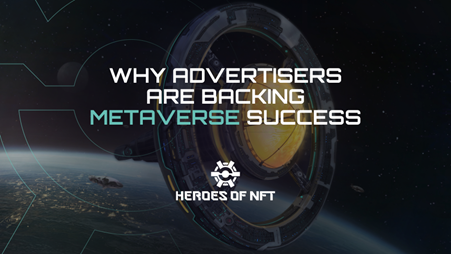Reason to trust

How Our News is Made
Strict editorial policy that focuses on accuracy, relevance, and impartiality
Ad discliamer
Morbi pretium leo et nisl aliquam mollis. Quisque arcu lorem, ultricies quis pellentesque nec, ullamcorper eu odio.
Since the start of the social media revolution in the early 2000s, with social media sites like MySpace capturing mass attention, few developments have inspired and excited advertisers quite like the prospect of the metaverse. Already, major brands have been spotted among the first to snap up the best real estate in the most popular virtual worlds, often paying millions of dollars for the right to do so. Seeing that most existing metaverses have not been able to sustain their token price levels in the face of a tough bear market, these investments may appear unwise to some. Remarkably, many advertisers remain bullish, and for good reason.
The potential of the metaverse is that it will become a much larger, more immersive, and more interactive space than we’ve ever seen before. More so than Twitter, Facebook, Myspace, and Instagram, the metaverse can be virtual spaces that break the limitations of 2-dimensional timelines and newsfeeds. Run, jump, fly, game, laugh, dance, and bond with friends in ways you never imagined. For advertisers, the opportunity is clear – a global audience that is engaged and interacting with digital spaces, the ability to see and track user behaviours and preferences, and the support of most metaverses to allow advertisers and major brands to get involved.
Advertisers Need to Think Like Gamers
Success for advertisers will not be guaranteed or automatic, far from it. Like we have seen with NFTs and crypto-brand collaborations, some appear to just be jumping on the bandwagon, whereas others genuinely want to promote the technology, build communities, and be progressive. We already know that many brands see this wave of tech as the new dot-com boom. For the metaverse, advertisers and brands need to think more like gamers than crypto degens, as it will be gaming that onboards the most users into the metaverse. That’s if the experts are correct in their estimates.
What does it mean to think like a gamer? In short, it really means that brands and advertisers need to play the game themselves, they need an intimate understanding of the virtual world, its mechanics, its tokenomics, and all of the beautiful interactions. A typical corporate perspective of throwing money at it and seeing what happens won’t work here; if a brand wants success in the metaverse, they need to be part of the storylines too. By being involved and invested in the games at a deeper level, they will understand their demographic and what type of content might best appeal to them and have the most success in terms of engagements. This will require a leap of faith on many occasions, with some metaverses wanting advertiser support before launching, and with post-launch metaverses perhaps being more selective about the advertisers they work with.
Beyond the Billboard…
If you think advertising in the metaverse will be as simple as paying for digital real estate, 3D billboards, and banner ads, you’re thinking like a Web2 person and not a degen. In the metaverse, there will be boundless opportunities for advertising, and since every metaverse will be designed and themed differently, that truth is only multiplied.
Here are some great examples of what brands have been doing in the Metaverse:
- Atari bought real estate in Decentraland (MANA) and The Sandbox (SAND) and then worked with the developers to embed Atari-themed games and events into their metaverses
- Food delivery company Deliveroo participated in Animal Crossing, catching a lot of attention by simulating their real-life services
- Nike is involved is several metaverse projects, most notably Roblox and Decentraland. In Roblox, Nike created NIKELAND, an online experience that allowed users to enjoy their apparel and specially-made activities. In Decentraland, thanks to Nike’s acquisition of RTFKT, some of their NFT shoe collections can be worn by avatars
- Sotheby’s, the world’s most famous auction house for priceless art and artefects made a huge progressive leap when it hosted a virtual gallery inside the metaverse, putting some of the most famous NFT artists on display
- US-based fast food chain Wendy’s entered the metaverse through Fortnite, where Travis Scott and Ariana Grande first made waves with digital concerts, but this time collaborating to create a food fight game. The game comes with the mission of destroying frozen beef, playing on Wendy’s mantra of ‘Fresh, never frozen beef”. The crossover went down very well in the Web3, gaming, and digital marketing communities
The opportunities are truly limitless because Web3 is no longer working within the confines of social media image and video dimensions, and needing to post at certain times to reach certain audiences. These will be around-the-clock global digital spaces for social interaction and immersion. If there are rules, nobody really knows them yet. The advertisers that get involved first will have a real first-mover advantage and influence, getting a chance to write the rules of best practice along the way and gain further social credit.
Storyline Integration
As touched on before, there’s a huge opportunity for brands and advertisers to work directly with metaverses to embed themselves into narratives and the fabric of the world. Blockchain, crypto, and Web3 projects love to announce partnerships with major brands (Atari, Samsung, Adidas and Nike all own metaverse real estate), as it earns social credit and new audiences, so whilst the brand might be looking to unlock new customers from the metaverse, the same is true the other way around.
Imagine a fashion-themed metaverse. Clothing brands would not only want to get their designs inside the space as fast as possible, but they’d want to look at how they can become a part of storylines and encourage avatars to sport their wares. If your metaverse is on a gigantic spaceship escaping a post-apocalyptic Earth, as is the case with Heroes of NFT and their upcoming Phosphania launch, the storylines would be completely different. This kind of narrative would give brands the opportunity to be seen as timeless, futureproof, and robust. Those brands who see this opportunity can build not only awareness but loyalty and familiarity.
Intelligent Design & Social Spaces
Touching on Heroes of NFT (HON) again, it is an ambitious metaverse project being built on Avalanche (AVAX) at an interesting time in the metaverse journey. At this stage on their development, having sold out a 16,000 NFT collection and launched a hugely popular idle card game based on collectable trading cards on their test subnet , the team has proved that they can build games, spaces, designs, and communities that really engage. Advertisers in pursuit of a metaverse ripe for collaboration will surely be paying attention to the upcoming HON land sale.
Where most metaverses lead with the land sale, almost acting as an ICO to raise the capital to build the space, Heroes of NFT has already built a sustainable business model, gaming community, and solid team. Among that team, excitingly, are real-world architects. Advertisers and brands might be interested to know that HON’s metaverse will bring real-world concepts into play, especially when you consider the narrative of a space station leaving an almost-ruined Earth. There will be familiar social spaces, a town square, a cinema, a holographic zoo, clothes stores, and much more, all built by real architects. This gives advertisers familiarity over where they might want to place banners and posters in the space (if they still want to, considering the innovative approaches being taken by other brands).
In the metaverse, people are looking for a place where the social and digital seamlessly merge together, creating unique and memorable online experiences. When this works, word of mouth will act like wildfire, and mass adoption will drive new users to create their avatars and get started. While space station metaverses might appeal to tech companies, and digital malls could catch the attention of fashion brands, the truth is that the potential is limited, and advertisers have as much reason to find a metaverse that resonates with them as their target demographic does. There will be a space for everyone.
Verdict: Many Reasons to be Excited
While the metaverse appeals to a broad audience of web3 enthusiasts, investors, and Web3 and Web2 brands, advertisers stand to gain immensely from this nascent space. How they go about that could be overwhelmingly successful, with opportunities for advertisers in this growing space including avatar fashion, targeted advertising, gameplay rewards, narrative integration, and more.
Advertisers will have new ways to track user engagement, analyse data and behaviour, and collaborate with metaverse builders to create effective campaigns. As the metaverse grows, and AR/VR technology alongside it, further innovations will allow brands and advertisers to reach even more demographics and on even more platforms.



























